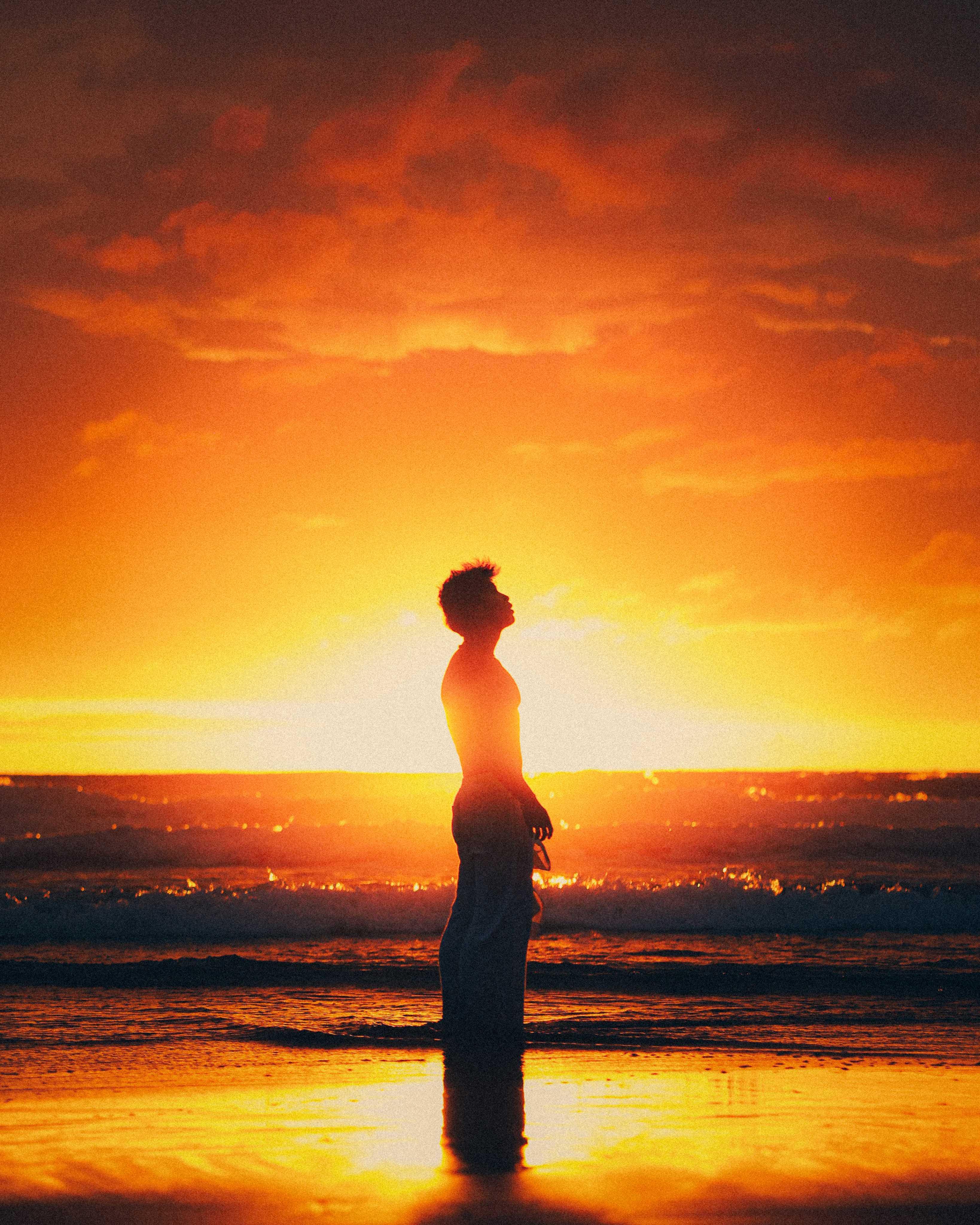by Drei.

Capturing the Unscripted
Filmmaker Andrei Gesmundo turns fleeting moments into lasting memories - raw, real, and never staged.



Capturing the Unscripted
Filmmaker Andrei Gesmundo turns fleeting moments into lasting memories - raw, real, and never staged.

Some filmmakers set out to tell storiesAndrei Gesmundo captures memories. His journey began with something simple: flipping on a trampoline, camera in hand, at just 12 years old. “Never thought anything of it,” he recalls. “But once I saw how different the world looks through a lens, I never looked back.” That early fascination turned into an obsession, shaping the way he sees the world—not just as it is, but as it feels.
Now, Gesmundo’s work is unmistakable. His grainy, nostalgic visuals are full of life, capturing not just moments but the emotions tied to them. “I always chased the beauty in film,” he says, though it wasn’t until recently that he even got his hands on a real film camera. Instead, he mastered the art of emulation, proving that it’s not about expensive gear—it’s about the vision behind the frame. “Every picture I take has a story behind it,” he explains. “That’s what pushes me to create - making sure every shot has value.”


work is more than just visually striking—it’s deeply personal. His films have an uncanny ability to feel like lived-in memories, transporting viewers into fleeting moments that resonate long after they’ve passed. This emotional weight isn’t accidental. It’s intentional. “Every picture I take has a story behind it,” he explains. “My true intention is to tell a story through my lens, which pushes me to make sure every shot has value.” His approach to filmmaking isn’t about perfection; it’s about capturing the raw, unfiltered essence of an experience. Rather than meticulously planning each frame, he lets the moment guide him. “I honestly hate the idea of preparing for a moment,” he admits. “Most of my shots just come from living in it, seeing it, and feeling it in real time.” This instinctive, run-and-gun style fuels the sense of authenticity in his visuals - nothing feels staged, yet every frame feels intentional.

His love for imperfection also extends to his color grading, a defining element of his work. While many filmmakers rely on high-end software, Gesmundo edits entirely on his phone. “I can’t afford the storage or budget for Adobe Lightroom on a computer,” he laughs, “but learning mobile Lightroom pushed my creativity in ways I never expected. I didn’t let the lack of fancy gear limit my vision.” For him, nostalgia is both a look and a feeling. “To have the energy of nostalgia, the look is what evokes the feeling,” he explains. That’s why his work embraces soft grain, imperfect lighting, and textured tones - visual cues that bring audiences back to a time they may not even remember, but somehow feel connected to.



There’s something magnetic about the way Andrei Gesmundo frames his shots. His work feels like a memory you’ve lived, yet can’t quite place—at once deeply personal and strikingly vast. It’s a fine balance, one that many filmmakers strive for, but few manage to achieve so effortlessly. “My go-to used to be the 12mm wide lens,” he shares. “I loved how much space it gave me to play with. But over time, I started venturing into tighter compositions. There’s so much beauty in what you can capture within a small frame—it feels more intimate.” His transition from expansive landscapes to tightly framed subjects reflects a broader evolution in his storytelling. “It’s all about what you want the viewer to focus on,” he explains. “A wide shot can show the world, but a close-up makes you feel the emotion within it.” For Gesmundo, composition isn’t just about technique—it’s about instinct. His ability to shift perspectives with subtlety is what makes his visuals so compelling. He captures both the grand and the granular, knowing exactly when to step back and when to lean in. “If you just take a couple steps back, you can create both scale and intimacy in a single shot,” he says. This delicate push-and-pull between distance and closeness is what gives his work such a strong emotional pull. This adaptability is at the heart of his filmmaking philosophy. While some directors spend weeks meticulously planning every frame, Gesmundo prefers the unpredictability of the moment. “I don’t like preparing too much,” he admits. “If it’s not client work, I prefer to let the moment guide me. There’s something about the rawness of just seeing a shot in real-time and capturing it right then and there.” This spontaneous approach is what gives his work a sense of authenticity— nothing feels forced, and yet every frame feels deliberate.

The relationship between space and intimacy also plays into how he builds emotion within his films. “I always want my work to feel personal, no matter the scale,” he says. Even when filming in larger-than-life locations, he ensures the human element is never lost. Whether it’s a subtle shift in focus or the movement of a subject within the frame, his compositions have a way of making even the most expansive landscapes feel deeply connected to the people in them.
It’s this instinctive, unfiltered approach that makes his work feel so alive. Whether he’s zeroing in on a fleeting expression or capturing the full scope of a scene, Gesmundo knows how to make his audience feel like they’re not just watching a moment unfold— they’re living in it.

For Andrei Gesmundo, the most powerful moments in filmmaking aren’t the ones you plan for - they’re the ones that happen when you least expect them. His creative process thrives on the unpredictable, on the electricity of a moment that can’t be recreated.
“I honestly hate the idea of preparing for a moment,” he admits. “If it’s not client work, most of my shots are just truly from the moment - seeing it, feeling it, and capturing it right then and there.” It’s a philosophy that runs counter to traditional filmmaking, where pre-planned shots and detailed storyboards are the norm. But for Gesmundo, too much preparation kills the magic. Instead, he embraces the chaos. His approach is often described as ‘run and gun’ - filming on instinct, reacting to what’s happening around him, and letting the energy of the moment dictate the shot.
“There’s a rawness that comes with shooting this way,” he explains. “You’re not just capturing an image - you’re capturing a feeling, exactly as it happens.”

This instinctive style allows for an authenticity that’s hard to manufacture. Life isn’t staged, and neither are his films. Whether it’s a fleeting glance, an unexpected shift in lighting, or the way movement unfolds naturally within a scene, Gesmundo thrives on imperfection. He believes that the beauty of filmmaking isn’t about making something flawless - it’s about somethingmaking real.
But that spontaneity also comes with challenges. “The hardest part is transferring what comes from your heart to your mind, and then from your mind to the actual shot itself,” he says. “Most of us creatives chase that feeling every day - the perfect shot that matches exactly what we envisioned.” It’s an endless pursuit, but one that keeps him pushing forward, constantly evolving, and refining his craft.
For Gesmundo, spontaneity isn’t just a technique - it’s a way of seeing the world. He doesn’t just film what’s in front of him; he captures the way it feels in that moment. And that, more than anything, is what makes his work resonate.

For Andrei Gesmundo, filmmaking isn’t just about what’s seen - it’s about what’s felt. His films carry an emotional weight that lingers, making the ordinary feel significant and the fleeting unforgettable. “The biggest challenge is transferring what comes from your heart to your mind, and then from your mind to the actual shot itself,” he explains. By letting emotion lead, his work feels more like a memory than a sequence of frames. It’s imperfect, raw, and deeply personal - crafted not just to be watched, but to be felt. Every shot has a story, and for Gesmundo, that’s the only thing that truly matters.
For all the fleeting moments Andrei Gesmundo has captured, there is one story that has lingered in his mind for years - one that represents not just a creative challenge, but a deeper calling. “I’ve always wanted to create a documentary on a particular culture,” he shares. His dream project? A film about the Bajau tribe, the nomadic sea people of the Philippines who have spent centuries living almost entirely on the water.
The Bajau are unlike any other community. Known for their free-diving abilities, they can hold their breath for extraordinary lengths of time, plunging deep into the ocean without modern equipment. Their homes are built on stilts above the water, their lives dictated by the rhythm of the sea. It’s a way of life that feels almost mythical - an existence in perfect harmony with nature. But as modernization encroaches and climate change threatens their waters, this ancient lifestyle is becoming increasingly fragile. “There’s so much beauty in their way of life,” Gesmundo says. “But it’s disappearing. That’s why I feel this pull to capture it, to document the stories that may not be told for much longer.”
For Gesmundo, this wouldn’t just be a documentary - it would be an immersive experience. He envisions a film that doesn’t just observe from a distance but places the viewer directly alongside the Bajau, witnessing their world as if they were part of it. “I want people to feel what it’s like to be there, to wake up to the sound of the ocean, to see how deeply connected they are to the water. I don’t want to just tell their story - I want to bring people into it.”


Despite his deep connection to nostalgia, this project wouldn’t be about looking back - it would be about preserving something before it’s lost. “I think filmmaking is about memory,” he reflects. “And this - this is a memory I don’t want to see fade away.”
For now, the film remains a dream, waiting for the right moment, the right opportunity. But Gesmundo knows it’s not a question of if - it’s a question of when. Until then, he continues refining his craft, capturing the raw beauty of everyday life, always searching for the kind of moments that make time stand still. One day, he’ll turn his lens toward the Bajau. And when he does, it will be a story worth remembering.
Yet, even as he looks toward the future, Gesmundo understands that filmmaking isn’t about reaching a final destination - it’s about the process. “If I’m being honest, I still haven’t made a project that feels like everything clicked,” he admits. “But what is art without imperfections?” That mindset keeps him moving forward, always chasing the next moment, the next story, the next frame that might bring him closer to that feeling.
His films don’t exist to impress - they exist to make people feel something. Whether it’s a quiet, intimate shot or an expansive, dreamlike sequence, his work is driven by the search for authenticity. He doesn’t overthink or over-plan. He trusts his instincts, capturing life as it happens, knowing that the best moments are the ones you can’t predict.
Because the most powerful stories aren’t the ones we control - they’re the ones that unfold in front of us. And as long as there’s something worth capturing, Gesmundo will be there, camera in hand, ready to press record.




